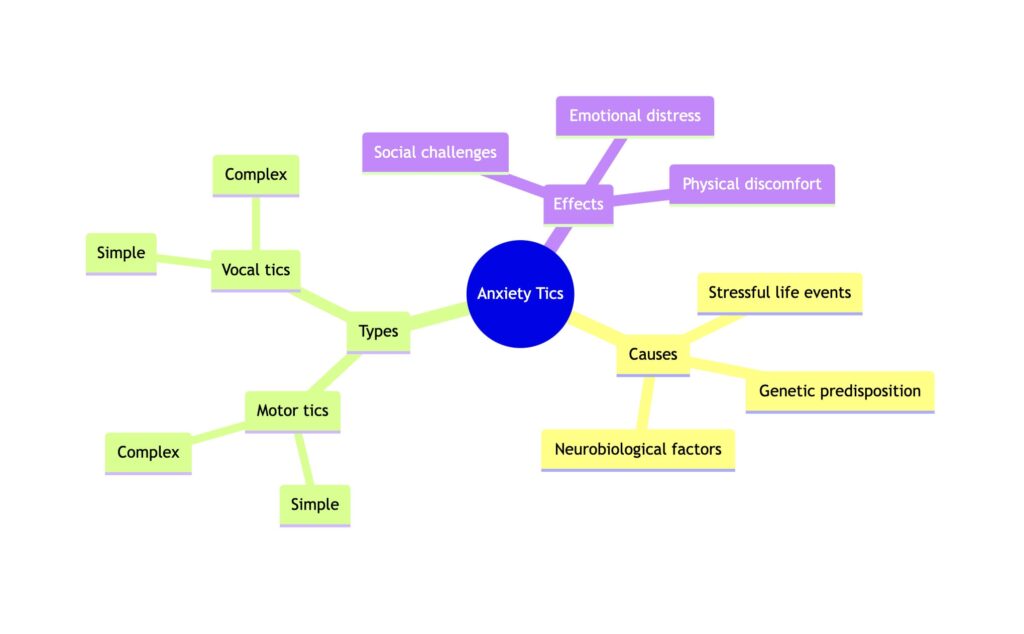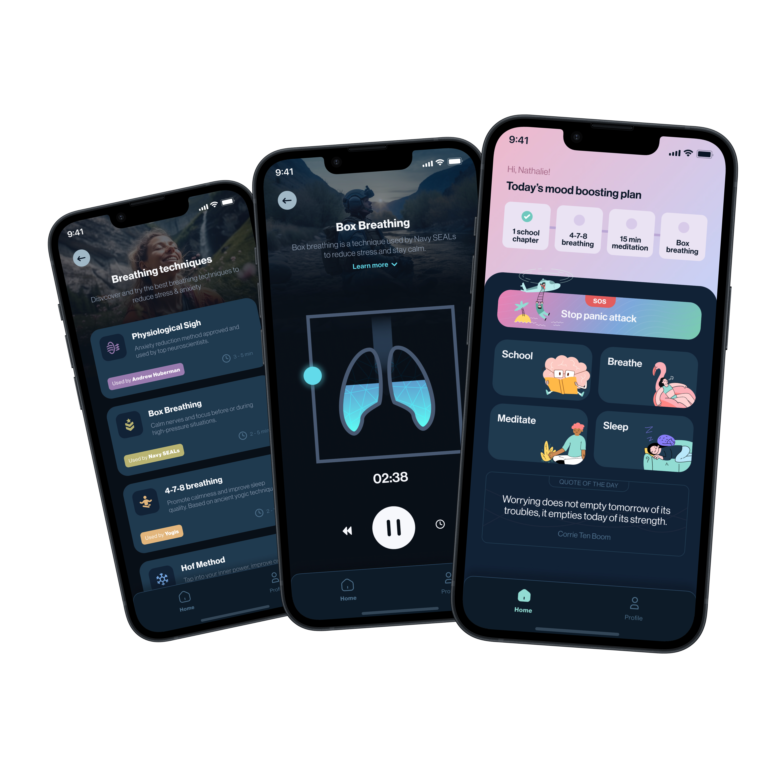
In response to stress and anxiety, individuals commonly experience involuntary, repetitive movements or sounds known as anxiety tics. These physical manifestations reflect a range of internal tension levels, from subtle to markedly noticeable. For those affected by them, understanding the crucial connection between anxiety and these tics is essential for both personal well-being and their support systems at large.
What Are Anxiety Tics?
Anxiety tics are described as sudden and repetitive movements or sounds. There are two main types of anxiety tics – motor and voice tics. Motor tics, for instance, encompass actions like eye blinking; shoulder shrugging – and facial grimacing: vocalizations such as throat clearing – and grunting are also included in these categories. Closely tied to stress levels, temporary manifestations often define anxiety tics specifically.
Anxiety tics are prevalent across all age groups; however, they are more frequently observed in children and teenagers. These tics are often linked to moments of heightened emotional stress.

Causes and Triggers
Biological, environmental, and psychological factors can induce anxiety tics. A family history of either tic or anxiety disorders increases the risk. Neurological factors—specifically those related to neurotransmitters such as dopamine—also play an integral role.
Trauma, environmental challenges, and life stressors can cause or exacerbate tics. It is crucial to comprehend and manage these triggers. The occurrence of tics is intimately linked with emotional states, particularly anxiety and stress. Other mental health conditions, like OCD or ADHD, can also influence their appearance.
Symptoms and Diagnosis
Anxiety tics manifest as sudden, repetitive motor or vocal behaviors, often intensifying with stress and diminishing with relaxation. Diagnosing these tics involves evaluating symptoms, and medical history, and excluding other neurological conditions. This process usually involves psychologists, psychiatrists, and neurologists.
Distinguishing anxiety tics from other conditions like Tourette syndrome, transient tic disorders, or medication side effects is crucial for accurate diagnosis and treatment.

Impact on Daily Life
Individuals with anxiety tics often intensify their self-consciousness and anxiety, especially in social situations; this may result in the avoidance of such interactions, an action that subsequently escalates stress and increases the tics.
Tics disrupt focus and performance in work or school settings; they necessitate frequent breaks; others may misunderstand them, posing potential communication challenges. The limited public awareness of anxiety tics exposes individuals to stigma, a situation that directly impacts their self-esteem and mental health.
Treatment and Management
While there is no specific medication for anxiety tics, drugs used for anxiety or tic disorders can be helpful. These include SSRIs for anxiety and neuroleptic medications for severe tics, though individual responses and side effects vary.
Cognitive Behavioral Therapy (CBT) is effective in managing anxiety that exacerbates tics. Habit Reversal Training, a part of CBT, helps individuals become more aware of and control their tics. Regular exercise, a balanced diet, adequate sleep, mindfulness, and relaxation techniques also aid in reducing anxiety and tics.
Support from family, friends, and support groups is essential for emotional support and understanding. Also remember that regular exercise, maintaining a healthy diet, and ensuring adequate sleep can help you significantly reduce anxiety and tics.
Latest Research and Developments
Recent research directs its focus toward comprehending their neurological basis. Exploratory studies dive into genetic markers and leverage advanced brain imaging techniques to gain insights. Such endeavors hold immense importance as they lay the pathway for novel and significantly more effective treatments. New methods in behavioral therapy continue to evolve, particularly those aimed at assisting individuals with anxiety tics.
Frequently Asked Questions
What distinguishes anxiety tics from Tourette Syndrome?
Anxiety tics are usually temporary and closely linked to stress, whereas Tourette Syndrome is a chronic condition with both motor and vocal tics.
Can anxiety tics disappear on their own?
Tics often lessen or vanish over time, especially in children. Managing anxiety is key to reducing their frequency and severity.
Are anxiety tics controllable?
Controlling tics voluntarily is challenging, but behavioral therapies can increase control.
Is there a cure for anxiety tics?
There is no cure, but treatments can manage symptoms effectively.
How do anxiety tics differ from other types of tics?
Anxiety tics are specifically triggered or worsened by stress and anxiety, whereas other tics may have different triggers or be part of a chronic condition like Tourette Syndrome.
Can lifestyle changes help with anxiety tics?
Yes, lifestyle changes such as regular exercise, a balanced diet, sufficient sleep, and stress-reduction techniques can help in managing anxiety, which in turn may reduce the frequency or severity of tics.
Are children more likely to outgrow anxiety tics than adults?
Children often experience a reduction or complete cessation of tics as they grow older, especially if the tics are stress-related, however in adults, the pattern of tics can be more persistent but still manageable with appropriate treatment.
Is it necessary to see a specialist for anxiety tics?
Consulting a specialist, such as a neurologist or psychiatrist, is advisable for a proper diagnosis and to discuss the most effective treatment options. They can provide professional advice and therapy suited to the individual’s condition.
How do I get rid of anxiety tics?
Managing anxiety tics often involves a combination of treatments. Therapy, particularly Cognitive Behavioral Therapy, can be very effective. Medications that treat underlying anxiety may also help. Lifestyle changes like stress reduction, regular exercise, and sufficient sleep are important. In some cases, mindfulness and relaxation techniques can also reduce the frequency of tics.
What do tic attacks feel like?
These tic attacks frequently seem uncontrollable; they may persist from mere seconds to several minutes. Rapid blinking, twitching, jerking movements—or vocal outbursts. These are the experiences people might encounter. The intensity and unpredictability of tic attacks can also cause emotional distress.
How do I know if I have tics?
Sudden, repetitive, and involuntary movements or sounds characterize tics. These may manifest as blinking, facial grimacing, shoulder shrugging, throat clearing, or grunting, particularly in response to stress or anxiety.
Is there a test for anxiety tics?
Anxiety tics do not have a specific test. Instead, diagnosis typically entails a clinical evaluation conducted by an esteemed healthcare professional. This process may involve reviewing the patient’s medical history, observing symptoms meticulously, and methodically ruling out other potential conditions.

Conclusion
Anxiety tics may seem disruptive and annoying, but they are a condition that one can manage. Learn to understand the nature of the tics, identify the triggers, and try different treatment methods. A combination of medical intervention with therapy along with lifestyle adjustments and healthy habits can significantly improve your overall mental health and help with managing anxiety tics. Essential for improving the lives of individuals affected by this condition: we must continue our research; we must increase awareness.
References and Further Reading
- Association with Psychopathologies: Tic disorders, including TS, are often associated with other psychopathologies like obsessive-compulsive disorder (OCD), attention deficit hyperactivity disorder (ADHD), various anxiety disorders, mood disorders, and oppositional defiant behavior (Kurlan et al., 2002).
- Tic Attacks and Anxiety: Episodes known as “tic attacks” in TS can resemble a combination of tics and functional neurological movements, with a significant relation to anxiety and panic. Psychological techniques used for anxiety disorders have been effective in reducing tic attacks (Robinson & Hedderly, 2016).
- Premonitory Urge and Anxiety: The premonitory urge in tic disorders, an unpleasant sensation preceding tics, shows a relationship with specific anxiety-related symptoms, particularly panic/somatic symptoms (Rozenman et al., 2015).
- Tics as Non-Verbal Communication: Tics have been described as an incontinent form of non-verbal communication linked to anxiety, obsessional, and aggressive urges (Lees, 1996).

